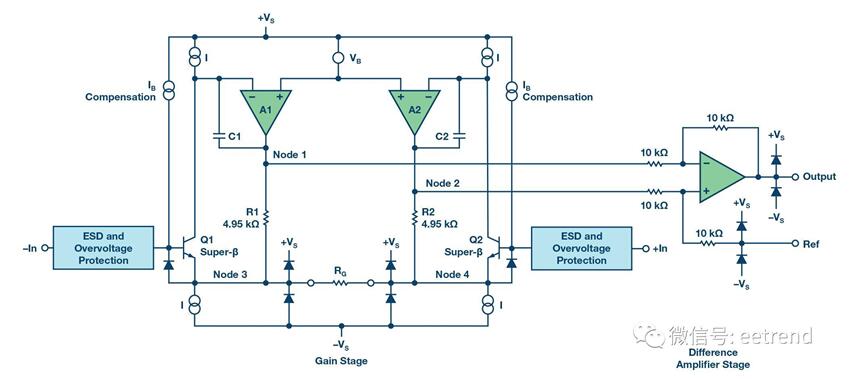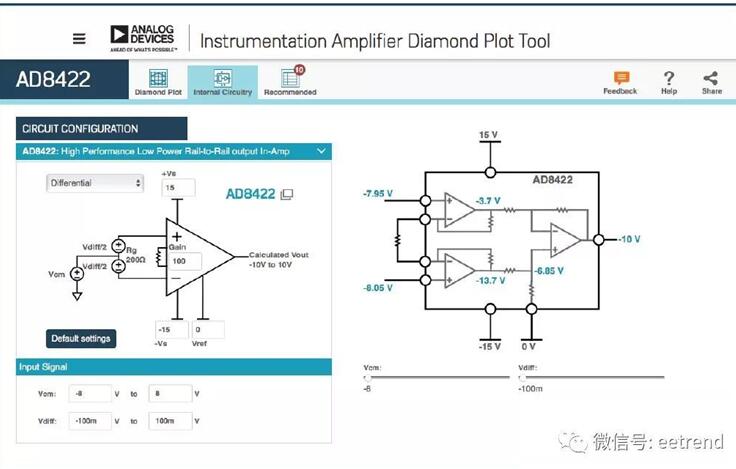ADI's instrumentation amplifiers are precision gain modules. The inputs are differential and the outputs can be differential or single-ended relative to the reference. These devices can amplify the difference between the two input signal voltages while suppressing any signals that are common to both inputs. Instrumentation amplifiers are widely used in many industrial, measurement, data acquisition, and medical applications. These applications require dc accuracy and gain accuracy to be maintained in noisy environments, and there is a large common-mode signal (usually AC power line frequency).
Instrumentation Diamond Diamond ToolInstrumentation Amplifier Diamond Diagram Tool is an online tool developed by Analog Devices that can be used for such calculations. The tool automatically calculates the possible configurations for the reference voltage, input signal, supply voltage, and gain of the desired output signal. It graphically displays the possible parameter combinations for a particular output signal.
The Diamond Graph Tool is a web application that generates a specific configuration of output voltage range vs. input common-mode voltage, also known as a diamond plot, for an ADI instrumentation amplifier. Based on user input parameters such as power supply voltage, gain, and input signal range, the tool can detect saturation of the design, recommend a suitable instrumentation amplifier to make the input signal within specification, and configure the circuit to be effective. This tool can avoid design saturation and find the best instrumentation amplifier for the design, saving design time.
The instrumentation amplifier is an excellent component for a variety of applications such as pressure or temperature measurement. Its main functions include signal amplification and impedance adaptation.
In many cases, the instrumentation amplifier has reference input pins. Increasing the voltage on the reference pin raises the output signal by the same voltage. This makes it easy and accurate to adjust the output of the instrumentation amplifier to the input level required by the ADC, allowing the ADC's full input range to be used while increasing the resolution. In the case of high common-mode signals, another advantage is the excellent common-mode rejection ratio and high accuracy.
Figure 1 shows the internal schematic of an instrumentation amplifier in a typical 3-op-amp design. The AD8421 is versatile and suitable for a variety of applications.

Figure 1. Internal Architecture of a Typical Instrumentation Amplifier
When using an instrumentation amplifier, it should be realized that the maximum output voltage depends on the input signal (common-mode or differential signal), gain, supply voltage, and possibly limitations from the internal structure. In a three-op-amp architecture, the first-stage amplifier (inverting and non-inverting inputs) amplifies the input signal with a preset gain. The second stage amplifier acts as a subtractor. The output signal is formed by subtracting two input signals. The reference voltage is added to the signal that produces the combined output.
After this internal analog signal is generated, different factors may now lead to internal saturation and may reduce the maximum working area. These factors are as follows:
1, the input voltage signal is too high for the preset gain
2. The reference voltage is too high for the generated output voltage signal
3, the power supply voltage is too low
The output voltage and instrumentation amplifier's operating area is dependent on the maximum input signal, gain, reference voltage, and the selected architecture limits, so both are computationally difficult. If you put these factors in a map, you can get a diamond map, the so-called diamond map. The space of the diamond plot represents a possible working area. It is not easy to calculate because there are multiple inputs and outputs.
Instrumentation Amplifier Diamond Diagram Tool is an online tool developed by Analog Devices that can be used for such calculations. The tool automatically calculates the possible configurations for the reference voltage, input signal, supply voltage, and gain of the desired output signal. It graphically displays the possible parameter combinations for a particular output signal.
The tool includes all ADI instrumentation amplifier specifications and is quick and easy to use.
Figures 2 to 4 show the tool's graphical user interface and its diamond diagram, internal circuitry, and suggested tool options for the corresponding window.
In the first window (Figure 2), you can enter all the required parameters, calculate the diamond map and visualize it (possible parameters include input signal, gain, supply voltage, and reference voltage). For input signals, you can select common mode signals or differential signals. In addition, the tool helps determine the limitations of the selected amplifier and distinguishes between input-output and internal limits. You can now estimate the work area. In general, it is recommended not to approach the diamond map limit too much during calculations.

Figure 2. Instrument diamonds
The second window of the instrumentation magnifier diamond plot tool provides an internal view of the amplifier and shows a detailed schematic (Figure 3). Through this view you can see the technical details and the respective internal voltages. This is very important when you need to check for possible errors in your design. Control modes are also provided to evaluate selected parameters and provide alternatives (Figure 4).

Figure 3. Instrumentation Amplifier Simplified Schematic

Figure 4. Recommended instrumentation amplifier
With the instrumentation amplifier diamond diagram tool, ADI can help you uncover the secret of the diamond map. The tool provides a simple user interface that is available 24/7 online, allowing you to select and evaluate a variety of instrumentation amplifiers and design more complex schematics at any time.
Smart Board For Conference,Whiteboard Smart Board,Interactive Whiteboard Smart Board,Smart Board Interactive Whiteboard
APIO ELECTRONIC CO.,LTD , https://www.displayapio.com